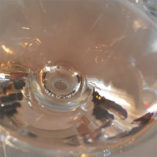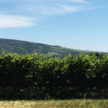Chiaretto (key-ar-et-toh) di Bardolino is a pale and crisp rosé produced in Northern Italy, on the shores of Lake Garda, 30 minutes away from Verona by car, exactly halfway between Venice and Milan. Even though Lake Garda is close to the Alps, its climate is Mediterranean and lemon trees, olive trees and Mediterranean scrub grow on its shores.
The name “Chiaretto” derives from the Latin adjective “clarum” meaning “light in color”. In Italian language “clarum” is “chiaro” and means “pale” or “light in color”. Chiaretto means something beyond pale, “a lighter shade of pale”. The light color is due to a limited contact of the must with the grapes’ skin, where anthocyanins are found.
On Lake Garda, the tradition of pink wines began in the Roman era. Lake Garda was part of the Roman province of Cisalpine Gaul (“cis” meaning “on this side” of the Alps), as was called Northern Italy back then as opposed to Transalpine Gaul (“trans” meaning “on the other side”), which referred to France and included present-day Provence. In Cisalpine Gaul and Transalpine Gaul the development of viticulture took place thanks to the Romans’ country villas. In these Roman country villas, they produced wine using the presses of the time. These allowed the grapes to be pressed, but with hardly any maceration. With very little maceration of the grape juice (“must”) on the skins, the wine that was obtained was pink and not red. As they were made with a press, the oldest wines from Lake Garda were pink (same for Provence wines, where the technique used was identical).
Despite these old tradition of pink wines produced on Lake Garda, the most ancient document mentioning the word “Chiaretto” referred to the wine locally produced is the edition of the “Crusca Vocabulary” (the official vocabulary of the Italian language) printed in Verona in 1806.
In 1968 Bardolino was amongst the first appellations in Italy to be awarded the Doc in recognition of the wine’s historic tradition and quality and it contained the Chiaretto typology. Since 2014 harvest, Chiaretto winemakers have put into effect the “Rosé Revolution”, emphasizing the very pale color and citrus notes of the main indigenous red grape of the area – Corvina – when softly pressed.
In 2021 Bardolino Chiaretto has officially changed the name in “Chiaretto di Bardolino”, thus underling not only its pale (chiaro) color, but also its origins in the town of Bardolino.
Produced both in the still and – in very small quantities – sparkling version, Chiaretto di Bardolino is the leader in the Italian rosé market, with a production of 10 million bottles per year. Its main markets are Italy and Germany, followed by with France, the Netherlands, Scandinavia, the US and Canada. Other countries, such as Japan, are increasingly appreciating it.
Freshness and citrus fruits are Chiaretto di Bardolino main features. Its aromas range from flowers to herbs, from citrus fruits to apricots and wild berries. On the palate, Chiaretto offers youthful, mouth-watering freshness and a typical “salinity”.
But where do freshness and salinity come from? The mystery about minerality can be solved when having a closer look at the soil. The morainic hills where Corvina is grown were created by ancient glaciers which eroded the rocks from the mountains and moved them downwards.
Soil and lake breezes, vinegrowers’ ability and high technology have allowed to create a rosé wine that can stand up even to the most demanding wine lovers. Take the chance to taste the only Mediterranean rosé with Alpine origins, take the chance to taste Chiaretto di Bardolino.
Chiaretto di Bardolino is perfect for every occasion all year round. From a relaxing after work with the partner to a swimming pool party with friends, during the summer at the seaside and in the winter chilled down directly in the snow, paired with pasta and pizza but also cheese, fish and sushi or Asian cuisine, it is always Chiaretto di Bardolino time.
![]()


